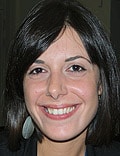BERLIN ― Aversion to bright light appears to be common in patients with panic disorder, new research suggests.

Dr Giulia Campinoti
A study presented here at the 27th European College of Neuropsychopharmacology (ECNP) Congress showed that photophobia, defined as extreme sensitivity to light, was significantly more prevalent among adult participants who had been diagnosed with panic disorder than among matched peers who were without the disorder. In addition, there was a significantly positive correlation between photophobia and panic disorder scores.
Lead author Giulia Campinoti, MD, from the Department of Mental Health at the University of Siena, Italy, told Medscape Medical News that the results themselves were not a surprise, but their degree of significance was.
"The photophobia scores were three times higher for those with panic disorder than for the controls, on average," said Dr Campinoti.
She noted that this is one of the first studies to look specifically at a possible association between light sensitivity and panic disorder.
"We've seen before that panic diseases tend to come out more in spring and summer. And we've seen that patients have more of these panic attacks from 6 in the morning until 6 at night. This study validates some of that," she said.
Strong Seasonal Component
The investigators add that clinical observances have often shown "a strong seasonal component in panic disorder," accompanied by high photosensitivity.
"This seems to contribute to the etiopathogenesis of the disorder and also to affect the course and response to therapy," they write.
"There have been several hints that photophobia is associated with panic disorder; for example, in some people, fluorescent light can induce panic attacks. It has also been noted that people with panic disorder often protect themselves from light, for example, by wearing sunglasses," reported Dr Campinoti in a release.
For the current study, the researchers enrolled 24 adult patients diagnosed with panic disorder (58% women; mean age, 39.7 years) and 33 matched peers to act as the "healthy controls group" (60% women; mean age, 27.6 years).
All the participants underwent the Mini International Neuropsychiatric Interview (MINI) and filled out the self-report versions of the Panic-Agoraphobic Spectrum Assessment (PAS-SR) and the Photosensitivity Assessment Questionnaire (PAQ).
The PAQ evaluates two aspects of photosensitivity: photophobia and photophilia (attraction to light).
Exclusion criteria included having any medical condition that could affect retinal function, having any psychiatric comorbidity, or taking any medication other than prescribed benzodiazepines.
Significant Light Sensitivity
As expected, the panic disorder group had higher total scores on the PAS-SR than did those in the healthy controls group (48 vs 16.12, P < .001).
However, the group with panic disorder also had significantly higher levels of photophobia than the healthy controls group (0.34 vs 0.11, P < .001), and lower levels of photophilia (P = .017).
When examining the entire group of participants, PAS-SR total scores were significantly associated with PAQ photophobia scores (P < .001), a pattern that was replicated when looking just at the panic disorder patients (P < .006).
"Given these results, it could be speculated that photosensitivity represents a trait characteristic in the panic agoraphobic spectrum, more than a feature related to symptom manifestation and that, as such, it could play a role in the predisposition to [panic disorder] or to episodes of panic within those already diagnosed," write the investigators.
"We believe that photophobia is one of the elements which may increase the risk of people suffering from panic attacks," added Dr Campinoti. "But this is a small study. So it needs to be confirmed by a longer-term follow-up trial."
She noted that future studies should examine whether an association between photosensitivity and panic attacks persist over time.
"If we can confirm this, then we may be able to take steps to avoid some of the triggers to panic attacks," she said, adding that the current findings only show an association and not causality.
"We don't yet know exactly what the relationship might be, but there is probably some underlying biochemical basis."
Siegfried Kasper, MD, professor and chairman in the Department of Psychiatry and Psychotherapy at the Medical University of Vienna, Austria, noted in a release that these results are very interesting.
In addition, the study "confirms our previous finding that anxiety components within depression cannot be treated with light therapy," said Dr Kasper, who was not involved with this research.
The study authors have reported no relevant financial relationships.
27th European College of Neuropsychopharmacology (ECNP) Congress. Abstract P.4.b.013. Presented October 20, 2014.
Medscape Medical News © 2014 WebMD, LLC
Send comments and news tips to news@medscape.net.
Cite this: Photophobia Linked to Panic Disorder - Medscape - Oct 29, 2014.






Comments